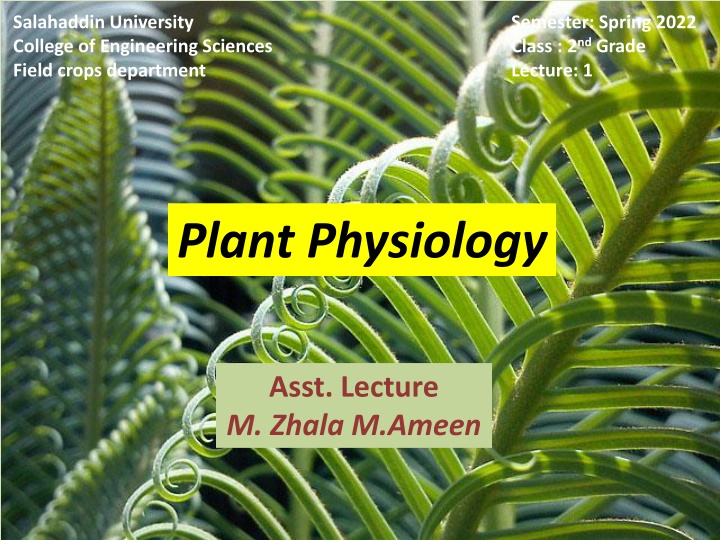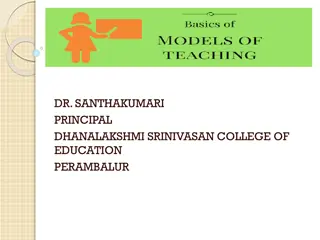
Plant Physiology and Solutions in Field Crops
Explore the definition of plant physiology, solutions, solvents, and components in the context of field crops. Learn about the importance of water in plant life and the difference between true solutions, colloids, and suspensions for a comprehensive understanding of plant processes.
Download Presentation

Please find below an Image/Link to download the presentation.
The content on the website is provided AS IS for your information and personal use only. It may not be sold, licensed, or shared on other websites without obtaining consent from the author. If you encounter any issues during the download, it is possible that the publisher has removed the file from their server.
You are allowed to download the files provided on this website for personal or commercial use, subject to the condition that they are used lawfully. All files are the property of their respective owners.
The content on the website is provided AS IS for your information and personal use only. It may not be sold, licensed, or shared on other websites without obtaining consent from the author.
E N D
Presentation Transcript
Salahaddin University College of Engineering Sciences Field crops department Semester: Spring 2022 Class : 2nd Grade Lecture: 1 Plant Physiology Asst. Lecture M. Zhala M.Ameen
Outline.. Definition of plant physiology. Definition of Solution & some examples. The components of solutions. They are two types of solvents. Importance of water in plant life. What are the Solubility and Emulsions. Classified the Solutions. Difference between true solutions, colloids and suspensions. Practical part.
Definition of plant physiology Is a study of the plant way of life, which include various aspects of the plant lifestyle and survival including (metabolism, water relations, mineral nutrition, development, movement, irritability, organization, growth and transport processes). Plant physiology processes:- 1- Is a lab science. 2- Is an experimental science. 3- Relies heavily on chemistry and physics.
Define the Solutions: Are physical mixtures of two or more substances, the parts of which are not chemically combined and can be separated relatively easily. Are formed when two or more substances are mixed on an atomic or molecular scale to form only, can be composed of (liquids, gases or solids).
The components of solutions 1. Solutes: is the substance in the lesser quantity in the solution. 2. Solvents: is the substance in the greater quantity. for example: in sea water there is a lot more water than salt, so the water is the solvent and the salt is the solute.
They are two types of solvents:- Non polar solvents. The most common non-polar solvents and solutes are the hydrocarbons. Manly found in crude oils and tars, hydrocarbons like (Petrol and mineral turpentine, will dissolve oils, grease, wax, methane gas) and most organic molecules. Polar solvents. Water is the most common polar solvent on Earth. It will dissolve (acid, ionic salts, alcohol, ammonia, sugars and even silicates from rock if under high pressure and temperature.
Importance of water in plant life. 1. Water consist the biggest part of protoplasm (80- 90)%. 2. Water is sharing in biological process either directly or indirectly. 3. Water dissolves some gases like (O2 or CO2). 4. Water is the medium of translocation of dissolved minerals and organic nutritional materials. 5. Water is playing a role in keeping turgid pressure.
Solubility Describes how much solute can be dissolved and held in each liter of solution. Generally: Solid and liquid more soluble in hot solvent than cold. Gasses more soluble in cold solvent than hot.
Emulsions. Are immiscible (incapable of mixing) colloidal suspensions of one liquid in another liquid, will separate into their individual components if allowed to sit for long enough. For example; face creams ,water and oil etc Emulsifying agents are to keep an emulsion stable or un separated, example (water and oil).
Solutions can be classified 1. True Solution.Is a homogeneous mixture of two or more substances in which substance solute in solvent has the particle size of less than (10-9)m or (nm), example (sugar in water).
2- Suspensions Is a heterogeneous mixture in which particle size of one or more components is greater than (1000)nm, example (flue in water).
3-Colloidal Solution Is a heterogeneous mixture in which particle size of substance is intermediate of true solution and suspension solution, between (1-1000)nm, example (sand in water). Some important properties of colloidal solution:- 1- Adsorption & increased surface area. 2- Brownian Movement. 3- Filterability. 4- Tyndall Effect.
Difference between true solutions, colloids and suspensions Property True Solution Colloidal Solutions Suspension Size of the particles Less than 1 nm 1- 1000 nm Greater than 1000nm Nature Homogeneous Heterogeneous Heterogeneous True particles diffuse rapidly through filter paper as well as parchment paper. Colloidal particles pass through filter paper but not through parchment p. Suspension particles do not pass through filter paper & par. paper. Filterability True part. Are not visible to naked eye. Colloidal part. Are not seen to naked eye but can be studied through ultra microscope. Suspension part. Are big enough to be seen by naked eye. Visibility Dose not show Tyndall effect. May or may not show Tyndall effect. Tyndall effect Show Tyndall effect. Appearance Transparent Translucent Opaque






















